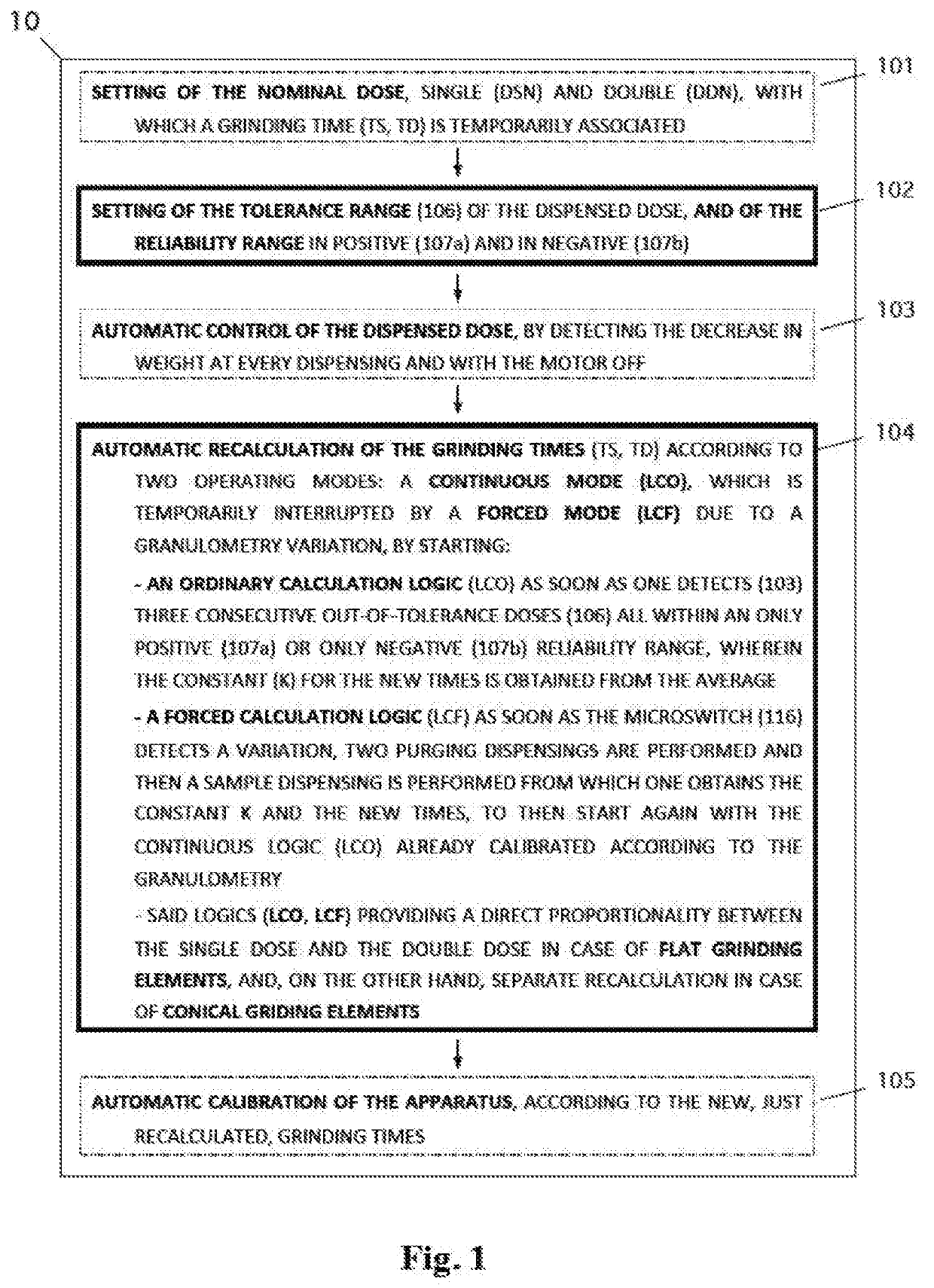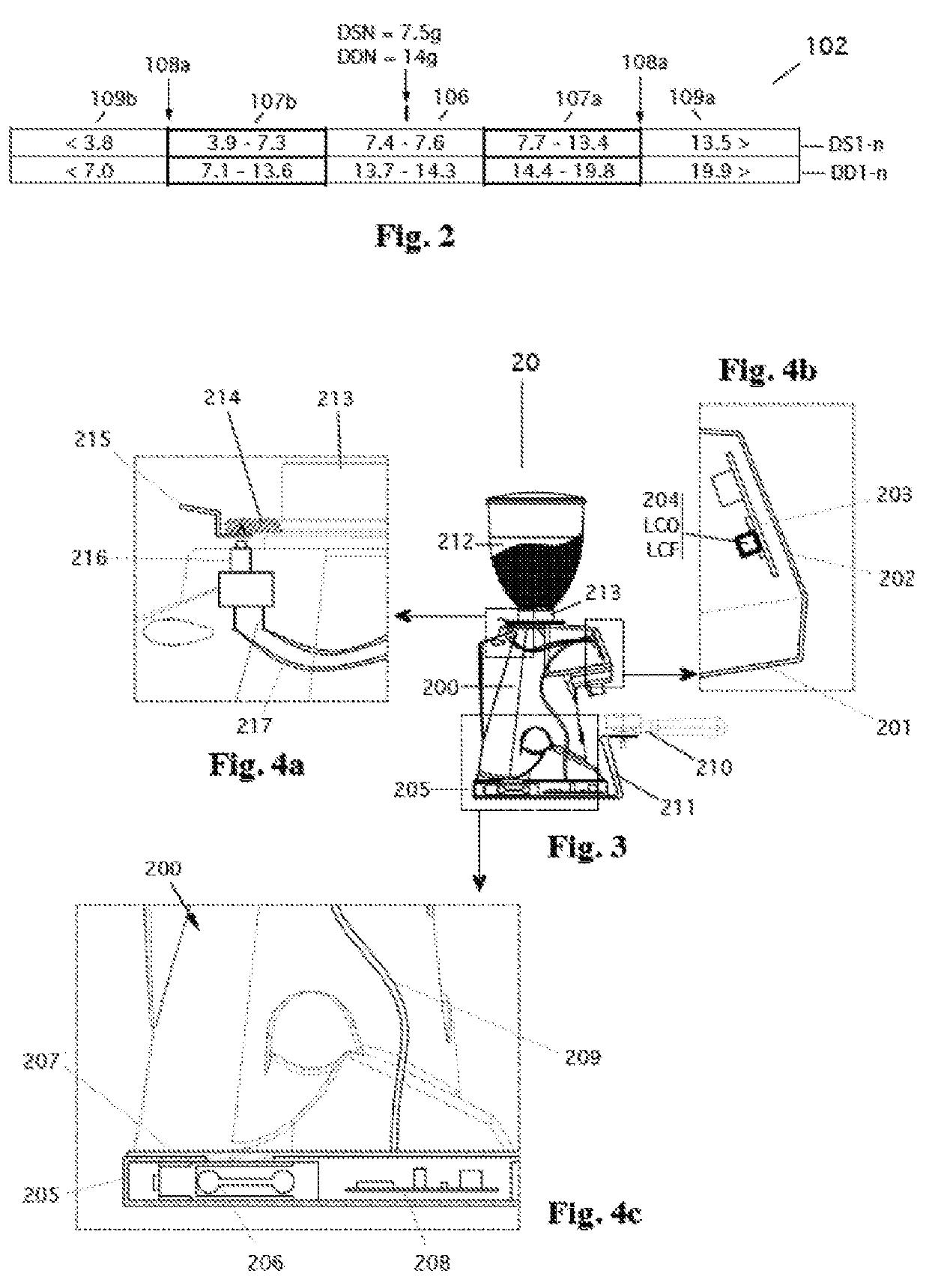Method for the instantaneous self-calibration of the dose for a coffee grinder-doser apparatus
a coffee grinder and doser technology, applied in the field of instantaneous self-calibration of the dose of a coffee grinderdoser apparatus, can solve the problems of unsolved problems, high detection accuracy, inconvenience in use, etc., and achieve the effects of reducing the occasions of distraction, fatigue or human error, and avoiding the time and/or sampling required by said operations
- Summary
- Abstract
- Description
- Claims
- Application Information
AI Technical Summary
Benefits of technology
Problems solved by technology
Method used
Image
Examples
example 1
Continuous Mode (LCO) with Flat Grinding Elements; Divergent Values of the Same Sign with Respect to the Nominal Value
[0073]With non-activation of the microswitch (216), in the continuous operating mode, the recalculation algorithm intervenes only when three consecutive doses, single or double, are dispensed, with out-of-tolerance, reliable values, and of the same sign, that is to say, all within said positive (107a) or negative (107b) reliability range, with respect to the set nominal value.
[0074]First setting (101):
[0075]DSN, that is to say, nominal single dose: dose weight in grams amounting to 7.5 g, with dispensing time (TS) of 2 sec;
[0076]DDN, that is to say, nominal double dose: dose weight in grams amounting to 14 g with dispensing time (TD) of 3.7 sec.
[0077]Detection (103) of three actually dispensed single doses, consecutive, out-of-tolerance and reliable (102):
DS1=4.1 g; DS2=4.2 g; DS3=4.1 g.
[0078]In this case there are 3 consecutive dispensings in negative (107b), thus t...
example 2
Continuous Mode (ICO) with Flat Grinding Elements; Divergent Values of the Same Sign with Respect to the Nominal Value but with a Double Divergent Dose Interposed
[0081]
DSI=4.1 g; DS2=7.8 g; DS3=4.5 g.
[0082]Three out-of-tolerance doses and within the reliability range are detected, which, however, are not all within the same positive (107a) or negative range (107b) with respect to the set nominal value: in this case the recalculation algorithm (LCO) does not intervene.
example 3
Continuous Mode (LCO) with Flat Grinding Elements; a Value Interposed by a Dose of Different Type
[0083]
DSI=4.1 g; DDI=7.6 g; DS2=4.2 g; DS3=4.1 g.
[0084]In this case, although a double dose is interposed, the software equally detects the three doses (DS1, DS2, DS3), out-of-tolerance, reliable and all in negative (107b), which are consecutive, considering the single dispensings only, thus the recalculation is activated. It is important to point out that the double dose, too, has considerably decreased with respect to the set nominal value, because, if the single dose varies, as a consequence the double dose will vary in the same way as the single dose; in this case, there being a direct ratio of 1 to 2 between the single dose and the double dose, the algorithm automatically recalculates time both for the single dose (TS) and for the double dose (TD). So, similarly to what has been set forth in Example 1:
DSM=4.1+4.2+4.1=12. / 3=4.1
K=TS / DSM=2 / 4.1=0.48
TS recalculated=K*DSN=0.48* 7.5=3.6 s...
PUM
 Login to View More
Login to View More Abstract
Description
Claims
Application Information
 Login to View More
Login to View More - R&D
- Intellectual Property
- Life Sciences
- Materials
- Tech Scout
- Unparalleled Data Quality
- Higher Quality Content
- 60% Fewer Hallucinations
Browse by: Latest US Patents, China's latest patents, Technical Efficacy Thesaurus, Application Domain, Technology Topic, Popular Technical Reports.
© 2025 PatSnap. All rights reserved.Legal|Privacy policy|Modern Slavery Act Transparency Statement|Sitemap|About US| Contact US: help@patsnap.com


